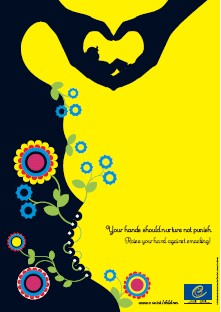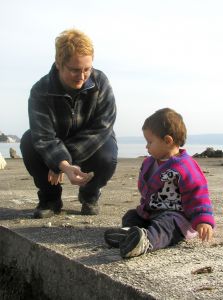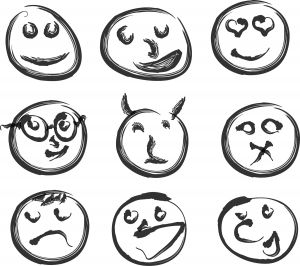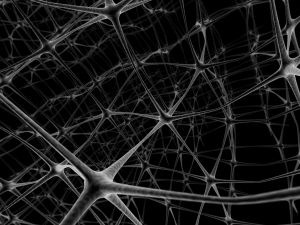From the Council of Europe
 The Council of Europe wants a continent free of corporal punishment. Hitting people is wrong — and children are people, too.
The Council of Europe wants a continent free of corporal punishment. Hitting people is wrong — and children are people, too.
To protect children from corporal punishment, the Council of Europe has developed tools for the use of governments, parliaments, local authorities, professional networks, civil society, and more generally, anyone caring for children.
Abolition of corporal punishment has become a global goal.
Criminalizing corporal punishment of children is not about putting parents in jail. Abolishing corporal punishment means promoting positive parenting.
What is Corporal Punishment of Children?
The United Nations Committee on the Rights of the Child defines corporal punishment as “any punishment in which physical force is used and intended to cause some degree of pain or discomfort, however light.”
Most corporal punishment involves hitting — smacking, slapping, spanking — children, with the hand or with an implement. It can also involve kicking, shaking, or throwing children, scratching, pinching, biting, pulling hair or boxing ears, forcing children to stay in uncomfortable positions, burning, scalding, or forced ingestion.
Why Should We Abolish Corporal Punishment of Children?
- It is a violation of children’s rights to respect for physical integrity, human dignity, and equal protection under the law.
- It can cause serious physical and psychological harm to children.
- It teaches children that violence is an acceptable way of resolving conflict.
- It is ineffective as a means of discipline. There are positive ways to teach, correct, or discipline children that are better for children’s development and for family relations.
- It is more difficult to protect children if corporal punishment is legitimate — this implies that some forms or levels of violence against children are acceptable.
Children are not mini-human beings with mini-human rights.
How Can We Achieve Abolition?
- Through law reform — introducing an explicit prohibition of all corporal punishment in all settings, including the home; ensuring there are no existing legal defenses that justify corporal punishment by parents or others; and providing guidance on appropriate enforcement of these laws.
- Through policy measures — ensuring comprehensive prevention policies and effective protection systems are implemented at different levels; and promoting positive, nonviolent forms of child-rearing, conflict resolution, and education.
- Through awareness — ensuring comprehensive awareness raising of the prohibition of corporal punishment, and of children’s rights in general.
Get Involved
This information is available in a variety of media materials from the Council of Europe. While this campaign is directed toward the European Union, this is a movement meant for all societies and is just as relevant for your community whether you live in London, Munich, Paris, Sydney, or Los Angeles. Click here to see all of the campaign materials that are available to print and pass along.
 When I was younger, my mother would take my sister and I to browse through little shops in our hometown full of local artisan’s crafts. She never bought anything; she just liked to look. On one of the trips when I was about eight years old, I spied a replica of a U.S. quarter about the size of a saucer and I just had to have it. I didn’t have any money with me, and when I asked my mom if she could buy it for me, she said no. So, when no one was looking, I put it in my coat pocket.
When I was younger, my mother would take my sister and I to browse through little shops in our hometown full of local artisan’s crafts. She never bought anything; she just liked to look. On one of the trips when I was about eight years old, I spied a replica of a U.S. quarter about the size of a saucer and I just had to have it. I didn’t have any money with me, and when I asked my mom if she could buy it for me, she said no. So, when no one was looking, I put it in my coat pocket. A new report released by Phoenix Children’s Hospital in collaboration with a researcher at the University of Michigan concludes that there is little evidence that physical punishment improves children’s behavior in the long-term. Rather, the report cites substantial evidence that physical punishment puts children at risk for negative outcomes such as increased aggression and mental health problems.
A new report released by Phoenix Children’s Hospital in collaboration with a researcher at the University of Michigan concludes that there is little evidence that physical punishment improves children’s behavior in the long-term. Rather, the report cites substantial evidence that physical punishment puts children at risk for negative outcomes such as increased aggression and mental health problems. Research has, for many years, shown that the way a child is parented will physically shape his brain — that each interaction, good or bad, will create pathways within the brain as a reflection of the emotions surrounding that interaction. And that a pattern of neglect or abuse will shape the brain differently than will a consistently loving, attachment-promoting relationship.
Research has, for many years, shown that the way a child is parented will physically shape his brain — that each interaction, good or bad, will create pathways within the brain as a reflection of the emotions surrounding that interaction. And that a pattern of neglect or abuse will shape the brain differently than will a consistently loving, attachment-promoting relationship. Through Attachment Parenting, we learn how truly powerful a close emotional relationship with our children can be. But even with the strongest of bonds, conflict will arise between parents and their children. As children grow, AP focuses more and more on how we, as parents, resolve conflict — in a gentle, positive manner that promotes influence, guidance, and teaching rather than control.
Through Attachment Parenting, we learn how truly powerful a close emotional relationship with our children can be. But even with the strongest of bonds, conflict will arise between parents and their children. As children grow, AP focuses more and more on how we, as parents, resolve conflict — in a gentle, positive manner that promotes influence, guidance, and teaching rather than control. Dear Readers,
Dear Readers, Custody cases are rarely pleasant, but in about 10 percent of these cases, it truly becomes a battle between the estranged parents and the long-term effects on their children’s mental wellbeing can be devastating.
Custody cases are rarely pleasant, but in about 10 percent of these cases, it truly becomes a battle between the estranged parents and the long-term effects on their children’s mental wellbeing can be devastating. Canadian parents who have been the target of parental alienation that is negatively affecting their attachment to their children now have the courts on their side. According to an article on TheGlobeAndMail.com, “Courts Can Rescue Kids From an Alienating Parent,” judges in Canada are now willing to intervene in such custody cases and remove children from homes of the alienating parent even if it’s against the child’s wishes.
Canadian parents who have been the target of parental alienation that is negatively affecting their attachment to their children now have the courts on their side. According to an article on TheGlobeAndMail.com, “Courts Can Rescue Kids From an Alienating Parent,” judges in Canada are now willing to intervene in such custody cases and remove children from homes of the alienating parent even if it’s against the child’s wishes.